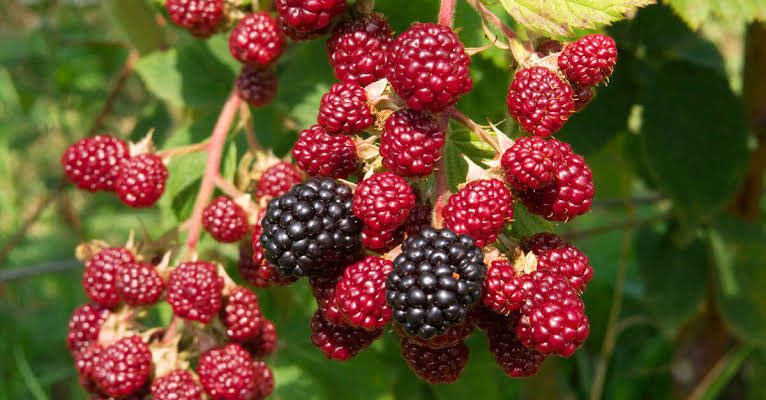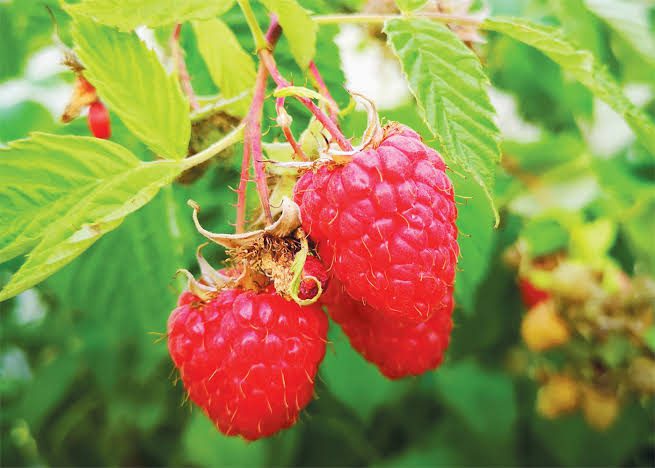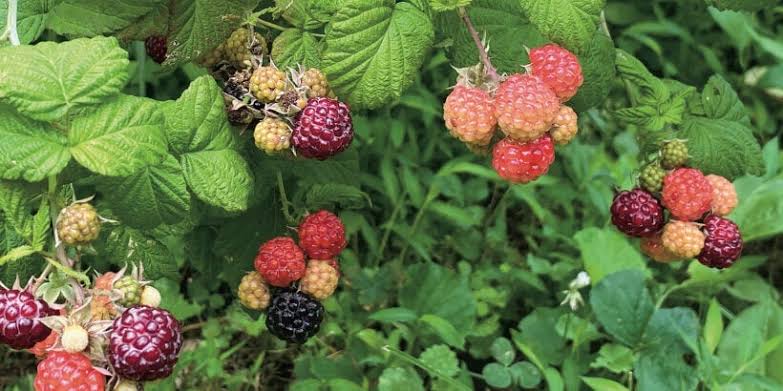Raspberries fruit which is scientifically known as Rubus idaeus are delightful, juicy fruits that come in various shades, from ruby red to golden yellow. These berries belong to the rose family and are not only tasty but also packed with goodness. Imagine a burst of sweetness in your mouth as you bite into a ripe raspberry – it’s a small fruit with big flavor.
These tiny wonders are rich in vitamins, particularly vitamin C, which is essential for a strong immune system. Eating raspberries is like giving your body a boost of natural goodness. Plus, they’re low in calories, making them a guilt-free treat for those watching their waistlines.
What’s fascinating about raspberries is their vibrant color, which comes from natural compounds called antioxidants. These antioxidants help protect your cells from damage, keeping your body healthy and happy. It’s like a colorful army defending your well-being!
Raspberries aren’t just delicious; they’re also versatile. You can enjoy them fresh, toss them into salads for a fruity twist, or add them to your morning cereal or yogurt. If you’re feeling adventurous, why not make a raspberry sauce to drizzle over desserts? The possibilities are as endless as the sweet, tangy taste of raspberries.
Growing raspberries can be a rewarding experience too. Whether you have a backyard garden or just a small balcony, these berries can thrive in various environments. With a bit of care and attention, you can have your mini raspberry haven, providing you with fresh, homegrown goodness.
Now, let’s talk about the raspberry plant itself. The plant has thorny stems, adding a touch of wildness to its appearance. Yet, don’t let the thorns deter you; the prize is worth the effort. Raspberry plants produce clusters of berries that gradually ripen, creating a beautiful visual display in your garden.
One interesting aspect is the pollination process. Raspberries rely on bees and other pollinators to transfer pollen from one flower to another, allowing the berries to develop. It’s like nature’s collaboration, where everyone has a role to play in the berry-making process.
In addition, raspberries are more than just tasty treats. They’re a symphony of flavor, color, and health benefits. Whether you enjoy them fresh, incorporate them into recipes, or cultivate your raspberry patch, these berries are a delightful addition to any lifestyle. So, savor the sweetness, embrace the vibrancy, and let raspberries become a cherished part of your fruity journey.
Read Also: Russian Blues (Felis catus) Cats Description and Complete Care Guide
History of Raspberries (Rubus idaeus)

The history of raspberries is a journey through time, spanning centuries and continents. These small, luscious berries have a story that intertwines with various cultures and regions.
Raspberries are believed to have originated in Eastern Asia, with their presence dating back to ancient times. Early records suggest that raspberries were enjoyed by the people of Troy in modern-day Turkey around 2000 BCE. From there, the cultivation of raspberries gradually spread, finding its way to Europe.
In medieval Europe, raspberries gained popularity for both their taste and perceived medicinal properties. Monks in monasteries cultivated raspberries, recognizing their potential health benefits. The berries became not only a culinary delight but also a remedy for various ailments.
As time marched on, raspberries found their way into royal courts and aristocratic gardens. The fruit’s association with wealth and luxury grew, becoming a symbol of abundance and indulgence. In 17th-century England, raspberries were cultivated in gardens, marking the beginning of a more systematic approach to berry cultivation.
The journey of raspberries across the Atlantic took place during the 17th century as European settlers brought the berry plants to North America. The fertile soils and diverse climates of the continent proved to be conducive to raspberry cultivation. Raspberries soon became a part of the American landscape, adapting to different regions and thriving in the wild.
By the 19th century, advancements in horticulture and agriculture led to the development of new raspberry varieties. Cultivators selectively bred plants to enhance flavor, size, and resilience, creating the diverse array of raspberries we know today.
The commercial production of raspberries took off in the 20th century, with various countries becoming significant contributors to the global raspberry market. Modern agricultural practices and technology have further optimized cultivation methods, ensuring a steady supply of raspberries throughout the year.
Today, raspberries continue to be celebrated worldwide. From being a staple in desserts and jams to starring in salads and smoothies, raspberries have secured their place as a beloved fruit across cultures. Their rich history is a testament to the enduring appeal of these little berries, which have transcended time and borders to become a cherished part of our global culinary heritage.
Nutritional Value of Raspberries (Rubus idaeus)

Raspberries are not just delicious; they also pack a nutritional punch. These small berries are a powerhouse of essential nutrients that contribute to overall health and well-being.
First and foremost, raspberries are an excellent source of vitamin C. This vital nutrient is known for its immune-boosting properties, helping the body fend off infections and illnesses. Just a cup of raspberries provides a significant portion of your daily recommended intake of vitamin C, contributing to a strong and resilient immune system.
In addition to vitamin C, raspberries are rich in dietary fiber. Fiber is crucial for digestive health, promoting regular bowel movements and preventing constipation. Including raspberries in your diet can help support a healthy digestive system and contribute to overall gut well-being.
Raspberries are also low in calories, making them a fantastic option for those looking to manage their weight. The combination of fiber and natural sugars in raspberries helps maintain a sense of fullness, making them a satisfying and guilt-free snack.
Antioxidants, the natural compounds found in raspberries, play a crucial role in protecting cells from oxidative stress. These antioxidants, including quercetin and ellagic acid, have been associated with potential health benefits, such as reducing inflammation and supporting heart health.
On the mineral front, raspberries contain essential nutrients like manganese, which plays a role in bone health and metabolism. The presence of manganese, along with other minerals, contributes to the overall nutritional profile of raspberries.
What’s impressive is that all these nutritional benefits come in a small, flavorful package. Whether you enjoy raspberries fresh, frozen, or incorporated into various dishes, you’re not just indulging in a delightful taste but also nourishing your body with a spectrum of essential nutrients.
So, the next time you savor a handful of raspberries, know that you’re not just treating your taste buds; you’re providing your body with a dose of vitamin C, fiber, antioxidants, and other valuable nutrients that contribute to a healthier and more balanced lifestyle.
Read Also: Himalayan Cats (Felis catus) Description and Complete Care Guide
Health Benefits of Raspberries (Rubus idaeus)

Embracing raspberries as part of your diet can bring forth a range of health benefits, making these tiny berries a nutritious addition to your meals. Here are some notable health advantages associated with consuming raspberries:
1. Rich in Antioxidants: Raspberries boast a wealth of antioxidants, including quercetin and ellagic acid. These compounds play a crucial role in neutralizing free radicals in the body, potentially reducing the risk of chronic diseases and supporting overall cellular health.
2. Immune System Support: With a high vitamin C content, raspberries contribute to a robust immune system. Vitamin C is known for its immune-boosting properties, helping the body defend itself against infections and illnesses.
3. Heart Health: The fiber, potassium, and antioxidants in raspberries collectively promote heart health. Dietary fiber helps maintain healthy cholesterol levels, while potassium supports proper blood pressure regulation. Antioxidants may also contribute to reducing inflammation, a factor associated with heart disease.
4. Weight Management: Raspberries are low in calories and high in fiber, making them an excellent choice for those aiming to manage their weight. The fiber content promotes a feeling of fullness, potentially reducing overall calorie intake.
5. Digestive Health: The dietary fiber in raspberries is beneficial for digestive health. It supports regular bowel movements, prevents constipation, and fosters a healthy gut environment. Including raspberries in your diet can contribute to overall digestive well-being.
6. Blood Sugar Regulation: Some studies suggest that raspberries may play a role in regulating blood sugar levels, which can be particularly beneficial for individuals with diabetes or those at risk of developing the condition.
7. Anti-Inflammatory Properties: The antioxidants found in raspberries may have anti-inflammatory effects. Chronic inflammation is linked to various health issues, so incorporating foods rich in antioxidants, like raspberries, may contribute to reducing inflammation in the body.
8. Eye Health: Raspberries contain compounds like zeaxanthin, which are associated with promoting eye health. These compounds may help protect the eyes from age-related macular degeneration and other vision-related issues.
9. Hydration: Raspberries have a high water content, contributing to overall hydration. Staying hydrated is essential for various bodily functions, including skin health, temperature regulation, and nutrient transport.
Incorporating raspberries into a well-balanced diet can be a flavorful and nutritious way to support your overall health. Whether enjoyed fresh, added to smoothies, or included in various recipes, these berries offer a tasty way to reap their numerous health benefits.
How to Grow Raspberries (Growing Guide)
Growing raspberries can be a rewarding venture, allowing you to enjoy the sweet fruits of your labor. Here’s a simple guide to help you cultivate raspberries successfully:
1. Selecting the Right Variety: Choose raspberry varieties that are well-suited to your climate. There are summer-bearing and everbearing varieties, each with its own fruiting season. Consider factors such as local weather conditions and the available space in your garden.
2. Site Selection: Raspberries thrive in well-drained soil with a slightly acidic to slightly alkaline pH. Choose a sunny location for your raspberry patch, as these berries prefer full sun exposure. Ensure the soil is rich in organic matter.
3. Planting: Plant raspberries in early spring or late fall. Space the plants about 2-3 feet apart in rows with 6 feet between rows. Dig a hole large enough to accommodate the roots, and plant the raspberries at the same depth they were in the nursery containers.
4. Support System: Raspberries benefit from a support system, especially if you have a larger planting. Install trellises or stakes to help keep the canes upright. This not only facilitates harvesting but also improves air circulation, reducing the risk of diseases.
5. Watering: Raspberries need consistent moisture, especially during the growing season and when the fruits are developing. Water deeply but avoid waterlogged soil, as raspberries are susceptible to root rot. Mulching can help retain soil moisture.
6. Fertilizing: Use a balanced fertilizer in the spring as new growth begins. Additionally, incorporate compost or well-rotted manure into the soil annually to provide essential nutrients.
7. Pruning: Regular pruning is essential for raspberries. Prune out old canes that have fruited, as they won’t produce again. For summer-bearing varieties, prune immediately after harvest. For everbearing types, prune in late winter or early spring.
8. Pest and Disease Management: Keep an eye out for pests like aphids and Japanese beetles. Use natural methods or insecticidal soap to control infestations. Fungal diseases, such as powdery mildew and rust, can be prevented by ensuring good air circulation and avoiding overhead watering.
9. Harvesting: Raspberries are ready for harvest when they easily come off the receptacle with a gentle tug. Harvest regularly to encourage continuous fruiting. Be gentle during picking to avoid damaging the delicate berries.
10. Enjoying the Fruits: Once harvested, raspberries can be enjoyed fresh, frozen, or used in various culinary delights like jams, pies, and smoothies. Share the bounty with friends and neighbors, as raspberries often provide an abundance of delicious berries.
Read Also: Membrane Geometries and Module Configuration
